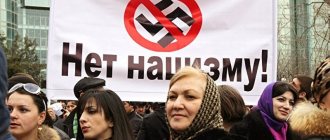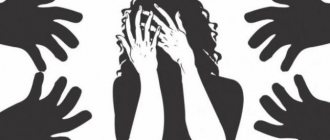Propaganda concept
Propaganda is understood as influencing people in order to form a stable opinion on a particular issue, as well as a certain value system. At the same time, the information provided may be biased and harm a person, interfering with his development.
To spread propaganda, they use simple arguments that are in tune with the basic attitudes of many people. Thanks to this, the slogans of propagandists are easily perceived by their consumers. And when such ideas become the opinion of large groups of people, then an argument in their favor is also the fact that the propaganda is accepted by the majority of people.
Those people who, due to developed critical thinking, do not accept such ideas, even in conditions of their mass popularity, become outcasts. Society begins to put pressure on them.
An illustrative example of the processes described is the rise to power of the Nazis in Germany. From promoting the ideas of the superiority of the German nation and the white race, they came to the creation of a powerful army and the outbreak of World War II. Given the millions of deaths that Nazi propaganda led to, it is now a criminal offense in many countries.
Who was tried and for what under articles about propaganda and rehabilitation of Nazism?
A car mechanic from Perm was the first to be convicted under the article on the rehabilitation of Nazism in 2016. He was fined 200 thousand rubles for reposting the text of the article “15 facts about Bandera, or What the Kremlin is silent about,” Kommersant reports. The article contained a statement about the fact of the joint attack of the USSR and Germany on Poland on September 1, 1939 and about the outbreak of World War II by these states. The conclusion made in the article about the “cooperation of communism and Nazism” was also recognized as criminally punishable.
In 2016, a resident of Krasnodar was ordered to pay a fine of 1.5 thousand rubles for publishing historical photographs and Soviet cartoons from the 1940s mocking fascism on social networks.
The published images contained Nazi symbols.
In 2016, a Chita court fined a member of the Communist Party of the Russian Federation 1.5 thousand rubles for distributing cartoons with swastikas on social networks.
The communist posted caricatures of the leaders of Ukraine and Turkey on social networks, in which a swastika was used.
According to TASS, a district court in Arkhangelsk found guilty of public display of Nazi symbols a man who posted a photo on a social network page with defeated fascist standards from the 1945 Victory Parade on Red Square. He was fined one thousand rubles, but the regional court subsequently overturned this decision.
“The photo shows defeated standards, this is not Nazi propaganda,” the press service of the Arkhangelsk Regional Court told TASS.
In 2015, a court in Smolensk sentenced the journalist to a fine of 1,000 rubles. She published photographs of the yard in which she lives, taken during the Nazi occupation, writes the BBC.
The photo shows the formation of a German military unit during the Nazi occupation of Smolensk, and on the left side of the photo is a flag with a swastika.
In early September, Fontanka.ru reported that an administrative case had been opened against a resident of Novokuznetsk for publishing on VKontakte the video of the group “Red Mold” “Punk Anthem” from 2005. There is a swastika in the cartoon clip. According to the plot of the video, punks fight the Nazis and defeat them.
In total, from 2012 to 2022, 6,622 people were punished for displaying Nazi symbols, Meduza writes, citing the Agora report.
A reconstruction of the events of the Great Patriotic War was staged in Barnaul.
press service of the Barnaul mayor's office.
Dissemination of prohibited propaganda as a crime
The methods described above for repeating ideas many times are widespread everywhere. They are used in advertising of goods, in the process of education and formation of values among the younger generation, for political and religious purposes. But this is not always illegal. What is the difference between these actions, if they all, in fact, fall under the concept of propaganda?
The main factor distinguishing such actions to shape public opinion is their consequences. If they form a healthy attitude towards their own life and the life of society, contribute to the development of the individual and improve his life, then such propaganda will not be considered criminal.
But when it leads to the formation of ideas of hatred and aggressive behavior, it poses a threat to the person himself and the entire society. Accordingly, such propaganda can lead to illegal actions. Therefore, legislation prevents the spread of ideas of hatred and the superiority of some people over others.
What should you not do on social networks to avoid being accused of promoting Nazism?
- You cannot publish or repost materials that in any way justify the Nazi regime and the actions of Nazi Germany during World War II. You should not publish critical and negative materials about the role of the USSR during the war.
- You should not publish or repost photographs of World War II and other images related to this time. They may contain elements of Nazi symbols.
- You cannot publish or repost any images with swastikas or other elements of Nazi symbols.
A reconstruction of the events of the Great Patriotic War was staged in Barnaul.
press service of the Barnaul mayor's office.
Laws prohibiting Nazi propaganda
Today in Russia there are three legislative acts prohibiting the dissemination of ideas or justification of Nazism:
- Federal Law No. 80 “On the perpetuation of the Victory of the Soviet people in the Second World War of 1941-1945.” It prohibits the use of Nazi symbols.
- Federal Law No. 114 “On combating extremist activities.” It refers to one of the forms of extremism as the spread of Nazi symbols.
- Code of Administrative Offenses of the Russian Federation, article 20.3.
Let's talk in more detail about administrative violations punishable by this article.
Responsibility under the Code of Administrative Offenses
When assessing actions to promote Nazism, the severity of the crime and the presence of additional aggravating features are considered.
In special cases, criminal liability occurs, and for less serious offenses – administrative liability.
The first part of Article 20.3 punishes the public display of Nazi or similar symbols, as well as other extremist symbols.
For individuals:
- The fine will be 1-2 thousand rubles.
- Arrest – up to 15 days.
Officials will be punished with a fine of up to 4 thousand rubles. Legal entities – from 10 to 50 thousand. Items with symbols will be confiscated in all cases.
The second part of Article 20.3 of the Code of Administrative Offenses determines the punishment for the manufacture of products with Nazi symbols. Penalties for this:
- For individuals – 1-2.5 thousand rubles.
- For officials - 2-5 thousand rubles.
- For legal entities – 20-100 thousand rubles.
Products will also be confiscated.
Specific actions that the law interprets as propaganda of Nazi symbols are:
- Public demonstration.
- Wearing.
- Hanging.
- Creating images.
- Reproduction and duplication in any way.
The shape and type of products with symbols does not matter. These can be any badges, stripes, flags, pennants, etc. The main factor in the crime is the public display of symbols.
What is Nazi symbolism?
According to Article 20.3 of the Code of Administrative Offenses, it is prohibited to promote and demonstrate attributes and symbols that:
- are Nazi;
- confusingly similar to Nazi ones;
- belong to extremist organizations.
There is no official list of prohibited Nazi symbols.
Fines.
Pavel Vodopyanov
Criminal penalty
If administrative sanctions are imposed for the demonstration of symbols or its production, then criminal punishment is provided for the desecration or damage of various objects for the purpose of promoting Nazism.
The most common crimes of this kind are the desecration of buildings, monuments or graves. Often followers of Nazi ideas paint their symbols on monuments to WWII soldiers.
This is punishable under Articles 214 and 244 of the Criminal Code of the Russian Federation.
Have a question for a lawyer? Ask now, call and get a free consultation from leading lawyers in your city. We will answer your questions quickly and try to help with your specific case.
Telephone in Moscow and the Moscow region: +7
Phone in St. Petersburg and Leningrad region: +7
Free hotline throughout Russia: 8 (800) 301-39-20
Statements that rehabilitate Nazism form a crime under Article 354.1 of the Criminal Code of the Russian Federation.
It is also worth remembering Article 282 for inciting hatred. Calls for national or racial hostility and discrimination fall within its scope.
The first part of this article includes the following sanctions:
- Fine 100-300 thousand rubles (or total income for 1-2 years).
- Ban on certain types of activities for up to 3 years.
- Mandatory work up to 360 hours.
- Correctional labor for up to 1 year.
- Forced labor and imprisonment for up to 4 years.
If there are aggravating circumstances (threat of violence, actions by an organized group, use of official powers), criminal actions will be classified under Part 2 of Article 282 and will be punished:
- Fine 300-500 thousand rubles (or total income for 2-3 years).
- Prohibition to engage in certain types of activities for up to 5 years.
- Mandatory work up to 480 hours.
- Correctional labor for up to 2 years.
- Forced labor or imprisonment for up to 5 years.
As can be seen from the listed sanctions, punishment for promoting Nazism can be very severe.
LiveInternetLiveInternet
Note. The comments specifically note that, in accordance with the decisions of the International Military Tribunal in Nuremberg, the leadership of the NSDAP, SS, SD and Gestapo are classified as criminal organizations.
Therefore, the following symbols are controversial: the Reichswehr, the Wehrmacht (the name of the German armed forces in 1933 - 1934, 1935 - 1945), branches of the armed forces - the Air Force, Navy, ground forces, operational control bodies of the German Armed Forces - the main command of the armed forces forces (Oberkommando der Wehrmacht, OKW); the main command of the ground forces (Oberkommando der Heeres, OKH); General Staff, Air Force Operations Command Headquarters (Oberkommando der Luftwaffe, OKL); Naval Headquarters (Oberkommando der Kriegsmarine, OKM); insignia of reservists, veterans and paramilitary organizations (Association of Veterans of the First World War (Kuffhauserbund), National Socialist German Union of Front-War Soldiers (First World War, NSDFB), Auxiliary Rural Police (Landwacht), Municipal Police (Gemeindepolizei), Security Police (Schutzpolitzei) , fire department (police, Feuerschutzpolizei), secret field police (Geheime Feldpolizei) - armbands, cockades, badges, neck plates, etc., as well as symbols of the Hitler Youth (Hitlerjugend) - a youth organization operating under the control of the NSDAP, breastplates ( qualification) badges certifying membership in the Hitler Youth, emblems, armbands (bandages), knives of Hitler Youth members, etc.
————————————————————— Propaganda
Propaganda refers to the systematic dissemination of facts, arguments, rumors, ideas, views, information and information for a specific purpose. Propaganda is distinguished from ordinary information, impartial publication of news and historical facts by two features: systematic dissemination and the presence of a goal - the formation of certain ideas, impressions, and, ultimately, a worldview that reflects the interests of the propagandist himself. To achieve the goal, the propagandist tendentiously selects some facts and discards others, presenting the essence of the matter in such a way that the impact on the reader’s consciousness is greatest. Even if he does it unintentionally, he still does it and sometimes achieves his goal. The deliberate filtering of information distinguishes propaganda from education or scientific research—for example, from the history of war.
Hereinafter, we mean not only the content of entries in a diary or community, but also comments, the name of the diary, epigraph, login, avatar, interests of the user, the content of his profile and signature under the nickname - absolutely all attributes can serve the cause of propaganda.
Public display
Publicity should be understood as the absence of restrictions on access - openness to an unlimited number of people. The property of publicity (glasnost) is the unpredictability of access, when it is impossible to say in advance who can read it. Thus, if access to an entire diary/community or a specific entry is limited to a previously known circle of people in one of three ways: “for the selected”, “for the list” or “closed to everyone” (open only to oneself), then such a demonstration of Nazi symbols will no longer be public, which means it is not prohibited. In this case, the owner of the non-public diary/community is responsible for observing public interests - access should not be open to people who are offended by the publication of Nazi symbols and paraphernalia.
In this regard, it should be understood that restricting access in another way does not achieve the desired goal - “prohibit indexing by search engines”, “access for registered”, “only for inverters” or “except for the list”, because the circle of persons who can read a diary or a specific entry, since any visitor to the site can become a registered user or PC, and, therefore, access remains public.
The law prohibits any propaganda and public display of Nazi (fascist) symbols and paraphernalia. It does not prohibit public demonstration.
In addition, according to the comments mentioned above, the law does not consider the reproduction of Nazi (fascist) symbols as an illegal act: 1) in publications describing historical events;
2) in feature or scientific films and publications condemning fascism; 3) in the description of religious rituals and traditions using signs of national heraldic symbols of any countries, when the corresponding symbols cannot be considered as Nazi (fascist).
The one-time placement of a picture with Nazi symbols in a post or comment cannot be considered as propaganda of Nazism, since it is not systematic.
However, placing the same picture in a permanent place: in a profile, in the epigraph of a diary, or in a systematically raised entry will be considered such propaganda, since it is shown every time the user’s most visited pages are opened. Places for systematic placement of attributes are also: login, avatar, signature under the nickname, name of the diary.
In accordance with paragraph 4 of Art. 1 of the Federal Law “On Combating Extremist Activities” extremist materials are understood as documents or information on other media intended for publication, calling for the implementation of extremist activities or substantiating or justifying the need for such activities. These include the works of the leaders of the NSDAP and the Fascist Party of Italy, text (or graphic, audio, video) publications and statements that substantiate or justify national or racial superiority or justify the practice of committing military or other crimes aimed at the complete or partial destruction of any -or ethnic, social, racial, national or religious group.
It should be noted that when identifying signs of extremism in comments, various traces of user activity on the site are examined, therefore individual comments, coupled with even a non-public diary containing Nazi symbols, may give reason to believe that there is a deliberate violation of current legislation, which prohibits any form of propaganda of fascism, ideologies of racial superiority in general, manifestations of xenophobia .
From all this it follows that those users who keep diaries/communities dedicated to or touching on the topics of Nazism and fascism should carefully study their contents and bring the entries into compliance with the requirements of the law and the described explanations.
Namely:
— if the user keeps a historical diary in which facts are impartially collected and described; or in which Nazism and fascism are condemned; or only religious rituals and traditions are described using the heraldry of Germany, which existed before the advent of fascism in it - it can remain public and open to search engines even if it contains pictures with Nazi (fascist) symbols;
- if the diary is not completely historical, then those entries in which (or in the comments of which) there are biased statements should be limited in one of 3 ways: open “for favorites”, “for the list” or “closed for all”, with This list should exclude the possibility of access by people whose feelings your entries may offend.
Please keep in mind that the law of the Russian Federation prohibits more than a thousand books, articles, photos, audio and video materials recognized as extremist, and their distribution is an offense.
Please note that the legislation of the Russian Federation (and not us and not you) prohibits NOT reading books and watching photos and videos from the prohibited list, but distributing them, including posting on the Internet both the materials themselves and links to them. No one has the right to give them even in closed records, and not just in the public domain.
Here is how the Supreme Court explained the controversial issues that arise:
Public appeals (Article 280 of the Criminal Code of the Russian Federation) should be understood as appeals expressed in any form (oral, written, using technical means, public information and telecommunication networks, including the Internet) to other persons with the aim of inducing them to carry out extremist activities.
When establishing the direction of appeals, it is necessary to take into account the provisions of the Federal Law of July 25, 2002 N 114-FZ “On Combating Extremist Activities.”
The issue of publicity of appeals must be resolved by the courts, taking into account the place, method, situation and other circumstances of the case (appeals to a group of people in public places, at meetings, rallies, demonstrations, distribution of leaflets, hanging posters, posting an appeal in public information and telecommunication networks, including the Internet, for example on websites, blogs or forums, disseminating appeals by sending out electronic messages, etc.).
The crime is considered completed from the moment of public proclamation (dissemination) of at least one appeal, regardless of whether it was possible to induce other citizens to carry out extremist activities or not.
Article 280 of the Criminal Code of the Russian Federation provides for liability only for public calls for extremist activities. Public dissemination of information justifying the need to commit illegal actions against persons on the basis of race, nationality, religious affiliation, etc., or information justifying such activities, should be qualified under Article 282 of the Criminal Code of the Russian Federation if there are other signs of this crime.
Public calls for terrorist activities, by virtue of the requirements of Part 3 of Article 17 of the Criminal Code of the Russian Federation, are subject to qualification not under Article 280 of the Criminal Code of the Russian Federation, but, depending on the circumstances of the case, under Part 1 or Part 2 of Article 205 [2] of the Criminal Code of the Russian Federation.
The crime provided for in Article 282 of the Criminal Code of the Russian Federation is committed only with direct intent and with the aim of inciting hatred or enmity, as well as humiliating the dignity of a person or group of persons on the basis of gender, race, nationality, language, origin, attitude to religion, belonging to any social group.
The question of whether the mass distribution of extremist materials included in the published federal list of extremist materials is a crime under Article 282 of the Criminal Code of the Russian Federation or an administrative offense (Article 20.29 of the Code of Administrative Offenses of the Russian Federation) must be resolved depending on the direction of intent of the person distributing these materials.
In the case when a person distributes extremist materials included in the published federal list of extremist materials with the aim of inciting hatred or enmity, as well as humiliating the dignity of a person or group of persons on the basis of gender, race, nationality, language, origin, attitude to religion, as well as belonging to any social group, what he has done should entail criminal liability under Article 282 of the Criminal Code of the Russian Federation.
It is not a crime under Article 282 of the Criminal Code of the Russian Federation to express judgments and inferences that use the facts of interethnic, interfaith or other social relations in scientific or political discussions and texts and do not pursue the goal of inciting hatred or enmity, as well as humiliating the dignity of a person or group of persons based on characteristics gender, race, nationality, language, origin, attitude to religion, membership in any social group.
// Resolution of the Plenum of the Supreme Court of the Russian Federation dated June 28, 2011 N 11, Moscow “On judicial practice in criminal cases of extremist crimes” //
STATE DUMA. Official site. https://asozd2.duma.gov.ru/main.nsf/(SpravkaNew)?OpenAgent&RN=64005-6&02
Other types of propaganda
The definition of illegal propaganda as ideas that harm individuals and threaten the social order is rather vague. Over time, the views of society change and what was considered taboo yesterday is now generally accepted and not at all condemned.
Therefore, exactly those ideas whose dissemination is prohibited by law are considered illegal propaganda.
Religion and atheism
The legislation of the Russian Federation defines freedom of religion. That is, a person has the right to both believe in religious dogmas and deny them. But neither a believer nor an atheist have the right to limit the views of other people, or to impose their point of view.
Drugs, alcohol, smoking
Since one of the most important values of society is the preservation of the health of its members, the promotion of the use of substances that worsen this health is a destructive effect on members of society. It especially affects young people.
Therefore, in many countries, drug promotion is strictly prohibited, and any advertising of alcohol and tobacco products is significantly limited.
Homosexuality and lesbian relationships
In many countries in Europe and America, the rights of sexual minorities are recognized by law and are protected by them. Although previously such relationships were considered abnormal and were persecuted.
Many other countries still criminalize homosexuality today. In Russia there is no such punishment, but homosexuals do not have the legal right to marry or adopt children. Accordingly, the propaganda of these actions is perceived critically by society.
Suicide
Typically, ideas of voluntary termination of life are spread by people with mental illness or representatives of a number of religious cults who consider suicide a way to speed up rebirth in a new body.
Such ideas pose a threat to society, therefore any propaganda of suicide is strictly prohibited.
Violence and cruelty
Despite the fact that these concepts reflect phenomena prohibited in any society, in practice, popular culture is replete with examples of the romanticization of violence and banditry.
Particularly bloody and cruel examples in cinema are prohibited, but there is no need to talk about a complete ban on the promotion of violence and cruelty.
War and terrorism
Terrorist acts and hostilities lead to mass death, destruction of property and cultural heritage, and often the destruction of entire countries.
Therefore, propaganda of such actions is clearly prohibited in almost any state.
How to deal with the problem?
The main method of struggle is considered to be state censorship, designed to regulate access to certain information. Products promoting Nazism are prohibited and withdrawn from public access. Access to some other types of propaganda is limited by age.
Given the universal use of the Internet, the state controls the content of various sites and can block access to some of them.
Of course, all these measures help limit propaganda in the area of legal access. But its illegal distribution is much more difficult to stop.







